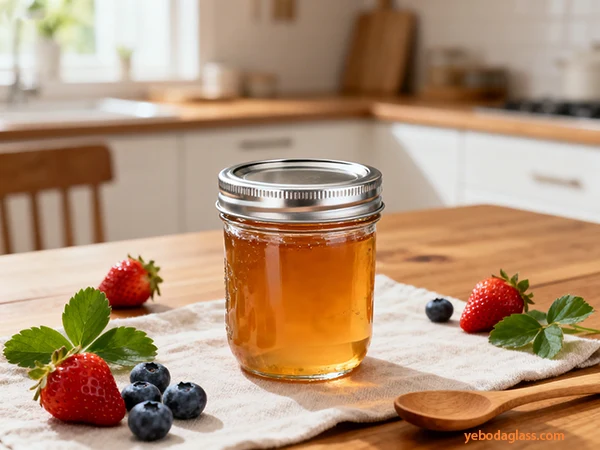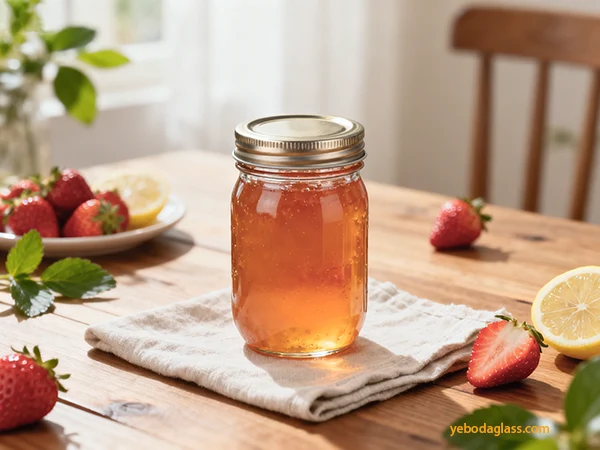소개
For businesses producing jam, jelly, protected, or special sauce, the purchase of high quality jam bottles in bulk is an important operation and financial idea. This guide provides a comprehensive outline for navigating bulk shopping, helps businesses in tailor supply chain strategies for their specific needs, makes informed decisions, reduces costs, and ensure frequent supply of appropriate packaging. Suppliers such as 네, 네. provide other benefits, including reliable production capabilities, better glass quality, flexible design and strong logistics support, ensuring that your jam jars meet your brand and operating standards.

Define Your Wholesale Jam Bottles Requirements
It is paramount to carefully define your jam bottles’ specifications before contacting suppliers. This ensures that the packaging meets functional needs, brand aesthetics, and regulatory compliance.
Size and Capacity
The capacity of the 유리병 is determined by the product’s net weight and market positioning.Normal sizes range from small (eg, 1.5 ounces, 4 ounces) to standard retail (eg, 8 ounces, 12 ounces, 16 ounces) and large family options (eg, 24 ounces, 32 oz). Consider both fluid ounces (FL OZ) and Ml (ML). Ensure declared capacity that sufficient headspace for product expansion during processing is allowed (eg, hot filling) and prevents lid deformation.
Size and Design
The glass bottle size affects brand perception, shelf appeal and logistics.
- Round: the most common, cost effective, strong and easy to label; Efficient for automated lines.
- Square/rectangular: Modern beauty, optimizing shelf space, but can be more delicate on corners and can be challenging for automation.
- Hexagonal/octagonal: Premium, artisan look, often more expensive, may require special labeling.
- Special size: unique discrimination, but high tooling costs and long lead time.
Consider the neck finish (eg, standard, wide-mouth) to ease and fill the consumer access. The base design affects stability.
Material Type: Glass vs. Alternatives
While the “jam bottles” usually mean glass, its advantages are important.
- Glass (primary focus): Industry standard is due to inert nature (preserves taste), excellent barrier properties (longevity), infinite recycling, transparency (showcase product), and premium feel.
- Plastic (limited use): Typically inappropriate or inappropriate for high-acid jams due to potential leaching, oxygen permeability and beauty boundaries. Glass is better for taste protection and shelf life.
- Other materials: Metal or ceramic is rarely used for consumer-support jam bottles due to cost, weight and ambiguity.
Lid Type and Compatibility
Lid is an integral part of integrity and shelf life.
- Lug lids (twist-off): Metal lid with bug that catches bottle thread. Popular for hot-fila, making a vacuum seal on cooling (“pop” sound). Easy to open and Reseal.
- Continuous thread (CT) lids (screw-on): continuous threading, metal or plastic, often with an airtight seal with an an airtight liner. Versatile, but warmth can require specific equipment for vacuum seals.
- Two-piece lids: Commercially low in home canning, due to labor and cost.
- BPA-free liner: necessary for food security and regulatory compliance; A non-conversion requirement.
Quantity and "Bulk" Definition
The “wholesale” is relative. For small producers, a pallet (2,000–3,000 bottles) may be bulk; For large operations, it is several truck load. Apparently define annual use and specific order volume, as it affects pricing, shipping and supplier selection. Understand the minimum order volume (MOQ) requirements.

Identifying Bulk Jam Bottles Suppliers
Sourcing bulk jam bottles involves various channels, each with distinct advantages.
Direct Manufacturers
- Benefits: Primary manufacturer of glass containers (eg, Owens-Illinois, Ardgh Group).
- 이익: The lowest unit cost for very high versions (truck load+), adaptation for unique shapes (high tooling costs/amouco), direct quality control.
- 단점: very high MOQs (hundreds of thousands), long lead times (weekends), limited product range, complex logistics.
Wholesale Distributor
- Details: Made from manufacturers resume in large quantities of companies and small bulk (eg, by print) (eg, froles container, Berlin packaging).
- 이익: Managing MOQs (often from a pallet), varied product range from many manufacturers, small lead times (hand inventory), price added services (labeling, kitting), logistic support.
- Damage: High unit cost due to markup, low adaptation.
Special Online Marketplace
- Benefits: E-commerce platform for packaging supply (eg, Alibaba, Amazon Business).
- 이익: Facility, competitive pricing (especially international), comprehensive selection.
- 단점: Quality control challenges (especially international), complex international logistics (customs, duty), communication barriers, best pricing in the best pricing require significant MOQ.
Small distributors or brokers serving specific geographical areas.
- Benefits: Personal service, closeness, shortening cost/time due to local pickup options.
- 이익: Certificate and Testing
- 단점: Food-grade certification:
Evaluation of Potential Suppliers
Reliability, quality and service only considering the value beyond the value, rigorous evaluation is necessary to choose the best partner.
Pricing Structure and Transparency
Get clear quotes for unit costs at various volume levels. Understand volume discounts, detailed freight costs (including overload, accessory fees), tooling costs for custom mold and payment conditions. Be cautious for hidden fees; Transparent suppliers provide comprehensive quotes.
Product Quality and Consistency
Non-conclusive for food packaging.
- Samples: Always request exact bottles and lid samples. Evaluate for clarity, finish (no line, bubbles), dimensional accuracy (coherent height, diameter, neck for equipment compatibility), weight (frequent glass distribution), and safe lid fit.
- Conduct the site or virtual audit of features and procedures. Food-grade compliance (eg, FDA, Rules of European Union) and verify ISO certificates.
- Batch stability: Discuss the quality control processes and tolerance of the supplier. Look for durable glass, reliable LID compatibility, and standardized sizes that are easily integrated into production lines.
Minimum Order Quantity
Ensure that the MOQs align with the quantity and storage of your production. Avoid over-ordering. Some suppliers can interact on MOQs, especially for new customers or for future orders.
Lead Time and Reliability
Understand production, shipping and total lead time. Buffer time causes for delay. Research supplier’s track record for on-time delivery and order accuracy.
Customer Aid and Communication
Assess the accountability, the availability of a dedicated account manager, and clear policies for the problem solution (eg, damaged goods, wrong orders).

Ability to Meet Specific Operational Demands
Inquire about adaptation options (shapes, colors, printing), specific packaging preferences (palette configurations, slip sheets, shrinking-rapping), and integrated solutions (lids, labels, other components).
Logistics, Shipping and Delivery
Logistics significantly affect the total cost and operational efficiency.
Freight Option
- Less than truck load (LTL): For orders not filling the truck. Cost-effective for small bulk (1–10 palette), but prolonged transit, high damage risk, low prognosis.
- Full truck load (FTL): For order to fill a truck (24-26 palette). The fastest transit, low damage risk, approximate program, low cost per unit for large versions.
- Intermediate: Combination of transport mode (rail/truck). Price effective for long distances, environmentally friendly, but long transit, more complex coordination.
Delivery Schedules and Lead Times
Coordinate delivery with production and warehouse capacity. Avoid rush orders. Ensure supplier/carrier adheres to scheduled delivery appointments. Utilize tracking services.
Geographical Considerations
Proximity to supplier reduces freight costs and transit times. For imports, port access is key. Ensure your receiving dock and equipment (forklifts) can handle large trucks and pallets.
Minimizing Shipping Costs
Optimize order size for FTL or maximum LTL pallet density. Negotiate freight rates. Inquire about backhaul rates. Ensure secure palletization (shrink-wrap, slip sheets) and adequate insurance.
Ensuring Timely, Damage-Free Arrival
Crucially, inspect every pallet/case immediately upon delivery. Verify counts against the bill of lading. Note any visible damage (crushed boxes, broken shrink wrap, glass shards) directly on the bill of lading before signing, and take photos. Train staff on inspection protocols.
Sourcing Related Canning and Packaging Supplies
A overall procurement approach streamlines production and provides cost savings through consolidated purchases.
Eyelids
Many bottle suppliers also provide compatible lids. Ensure an accurate matching of neck finish, specify the material (metal/plastic) and BPA-free liner, and consider custom printing for branding.
label
Label products are identification. Choose the suitable material (paper, bop, vinyl) and adhesive for your product environment (moisture, heat, temperature changes). Consider the printing method (digital for small runs, flexographic for large) and application method (manual/automatic). Make sure the design is attractive, informative, and complies with all food labeling rules.
포장재
Protect bottles during transit/storage. Use high quality corrugated boxes (specifying board strength), cardboard dividers, shrinking rap/stretch film, and suitable palette (standard wood, plastic, or heat-treatment for international/food security).
Specific Canning and Filling Equipment
- Reliable sources for devices are: filler (manual, semi-automatic, automatic), capsures (vacuum, screw), sterilizer/western and labelrs.
- Integrated sourcing strategy: Many wholesale distributors offer “one-stop shop” for bottles, lids, labels and packaging, simplify the purchase, reduce administrative overheads, and potentially offer better overall pricing.
Strategic Purchasing and Cost Optimization
Effective procurement involves understanding the total cost (TCO) of interaction, inventory management and ownership to maximize profitability.

Conversation Strategy
Inquire about tier volume discounts. Consider long -term contracts to guarantee preference pricing and supply. Interaction on favorable payment terms (eg, pure 30) or initial payment discounts. If you are arranging your own, then talk on goods rates. Many item bundles for better pricing. Solving competitive dialects from time to time.
Inventory Management Best Practice
The remaining supply with demand. Apply Just-in-Time (JIT) inventory for minimal storage costs and low risk, requiring reliable suppliers and accurate forecasts. Maintain security stock against demand spikes or delays. Develop strong sales forecasts. Monitor the inventory turnover. Adapt the warehouse layout for efficient storage.
Discovery of long term contracts
Offering stability and prediction: Guarantee of supply, price stability against market volatility, strong suppliers relationship, and administrative burden.
Analysis of total cost of ownership (TCO)
The TCO unit considers all direct and indirect costs beyond the price: purchase price, freight, inventory holding costs (storage, capital, untouchability/damage), quality cost (defects, inspections), administrative costs and opportunity costs (lost sales). A high unit value from a reliable supplier may result in the result in low TCO.
Exploring New Technologies and Contrarian Ideas
- AI-vacked demand forecast: Use advanced analytics for more accuracy, optimize orders and reduce waste.
- Blockchain for supply chain transparency: (speculation) can offer unprecedented transparency in the origin, quality and travel of the bottle.
- Re -purpose/refilable model: For local markets, explore consumer returns/refill models, require strong cleaning but align with stability.
- Lightweight initiative: Work without compromising strength to reduce the weight of glass to work with manufacturers, making significant freight savings.
- Automatic procurement system: Apply e-procurement platform to automate order placement, tracking and invoices, reduce errors.
By defining careful requirements, strategically evaluating suppliers, mastery in logistics, and adopting a comprehensive cost adaptation strategy, your business can secure a reliable, cost-effective supply of high quality jam bottles, which ensures smooth operation and profitability.
Read More Related Articles:




